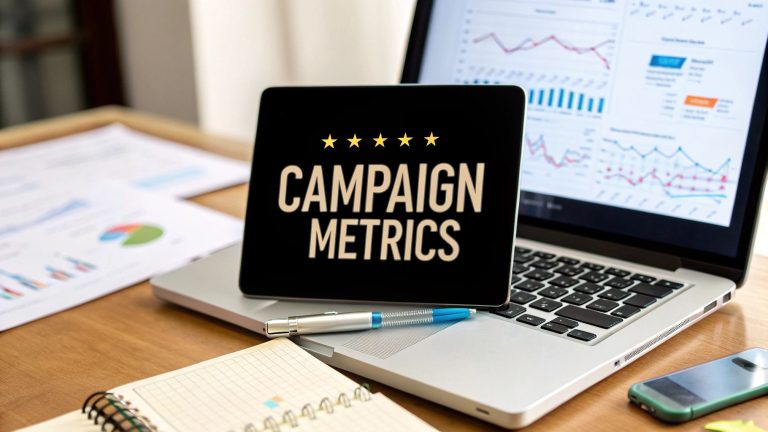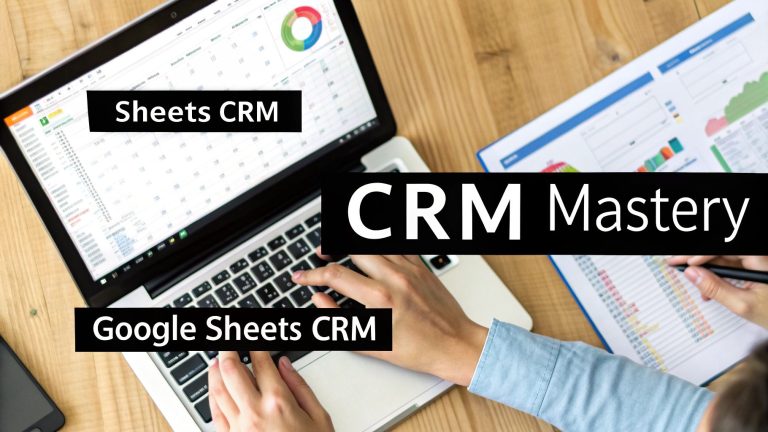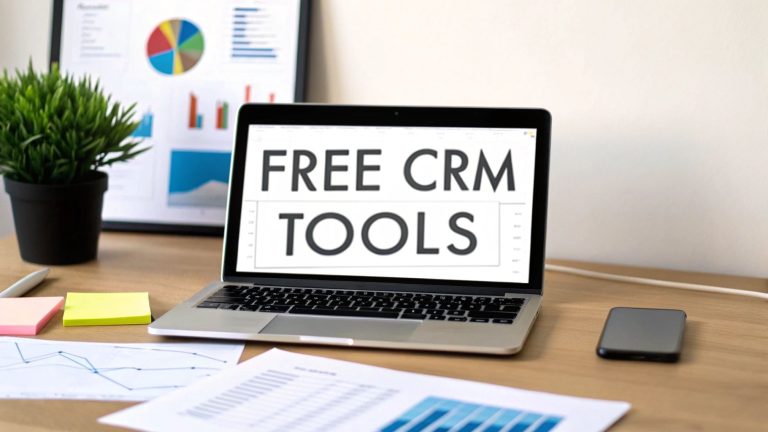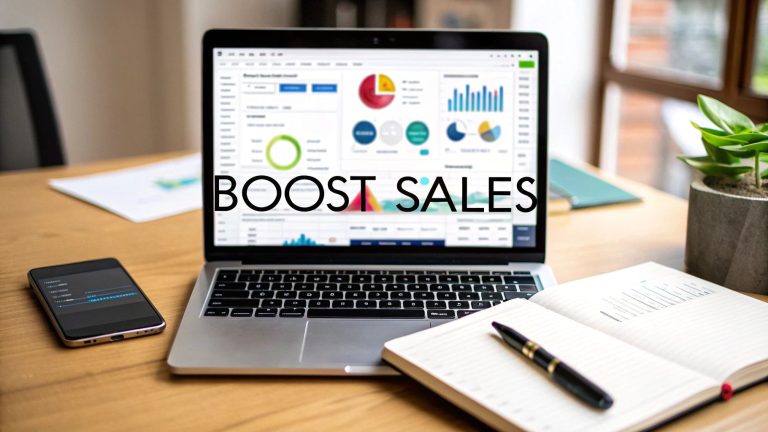10 Facebook Ad Best Practices to Dominate in 2025
The digital advertising landscape is constantly evolving, and what worked last year might not deliver results today. For advertisers on Meta's vast network, staying ahead requires more than just a budget; it demands a strategic approach grounded in proven techniques. This comprehensive guide moves beyond generic advice to outline the essential Facebook ad best practices that directly impact campaign success. We will provide actionable, data-driven insights that you can implement immediately to refine your strategy.
From mastering precise audience targeting and crafting compelling visual creative to optimizing your budget and tracking performance, each practice serves as a critical component of a high-performing advertising machine. The goal is to build a resilient and effective framework that consistently delivers results. Following these guidelines will help you navigate the complexities of the platform with confidence.
Whether you're aiming to boost brand awareness, generate high-quality leads, or drive direct sales, mastering these fundamentals is non-negotiable for improving your return on ad spend (ROAS). In this article, we will break down each of the top 10 best practices with detailed explanations, real-world examples, and step-by-step tips. This structure is designed to help you transform your Facebook ad performance from average to exceptional. Let’s dive into the strategies that will unlock your campaign's full potential.
1. Precise Audience Targeting
One of the most critical Facebook ad best practices is moving beyond broad, generic targeting and embracing precision. Instead of showing your ads to everyone, precise audience targeting allows you to focus your budget on the specific demographics, interests, and behaviors of users most likely to become customers. This approach leverages Meta's vast repository of user data to ensure your message reaches a receptive and relevant audience, significantly improving your return on ad spend (ROAS).
By defining a narrow audience, you increase the likelihood that your ad resonates deeply, leading to higher engagement and conversion rates. This is the difference between shouting into a crowd and having a meaningful conversation with a potential customer.

How to Implement Precise Targeting
To get started, navigate to the "Audience" section of your ad set creation in Ads Manager. Here, you can layer different targeting options to build your ideal customer profile.
- Demographics: Filter by age, gender, location, language, education level, and even life events like "newly engaged" or "recently moved."
- Interests: Target users who have expressed interest in or liked pages related to specific topics, such as "yoga," "digital marketing," or "vegan recipes."
- Behaviors: Reach people based on their purchase behaviors, device usage, and travel habits. For example, a travel company like Airbnb can target "frequent international travelers" aged 25-45.
Key Insight: The power of precise targeting comes from combining these layers. A local restaurant, for instance, could target users within a 10-mile radius who are also interested in "fine dining" and have an upcoming anniversary.
Actionable Tips for Success
Perfecting your audience requires continuous testing and refinement. Start with a well-researched hypothesis about your customer and adjust based on performance data.
- Start Broad, Then Narrow: Begin with a slightly broader interest group and use performance metrics to identify which sub-segments are most responsive.
- Utilize Audience Insights: Use Facebook's Audience Insights tool to discover new interests and demographic information about your existing followers or custom audiences.
- A/B Test Audiences: Create multiple ad sets with identical ads but different audience targeting to see which group performs best. For a deeper dive into setting up these campaigns, you can explore this detailed Facebook Ads Manager tutorial.
- Refresh Regularly: Don't let your audiences become stale. Periodically update your targeting to reflect new trends and remove underperforming segments.
2. Compelling Visual Creative
In a fast-scrolling social media environment, another core Facebook ad best practice is deploying compelling visual creative. Your visuals are the first point of contact with a user, and they must be powerful enough to stop them mid-scroll. High-quality, eye-catching, and brand-aligned creative is not just a nice-to-have; it's the element that captures attention and makes your message stick in a crowded feed.
Effective visual content works by immediately conveying value, evoking emotion, and differentiating your brand from competitors. It's the hook that draws a user in, making them receptive to your copy and call to action.
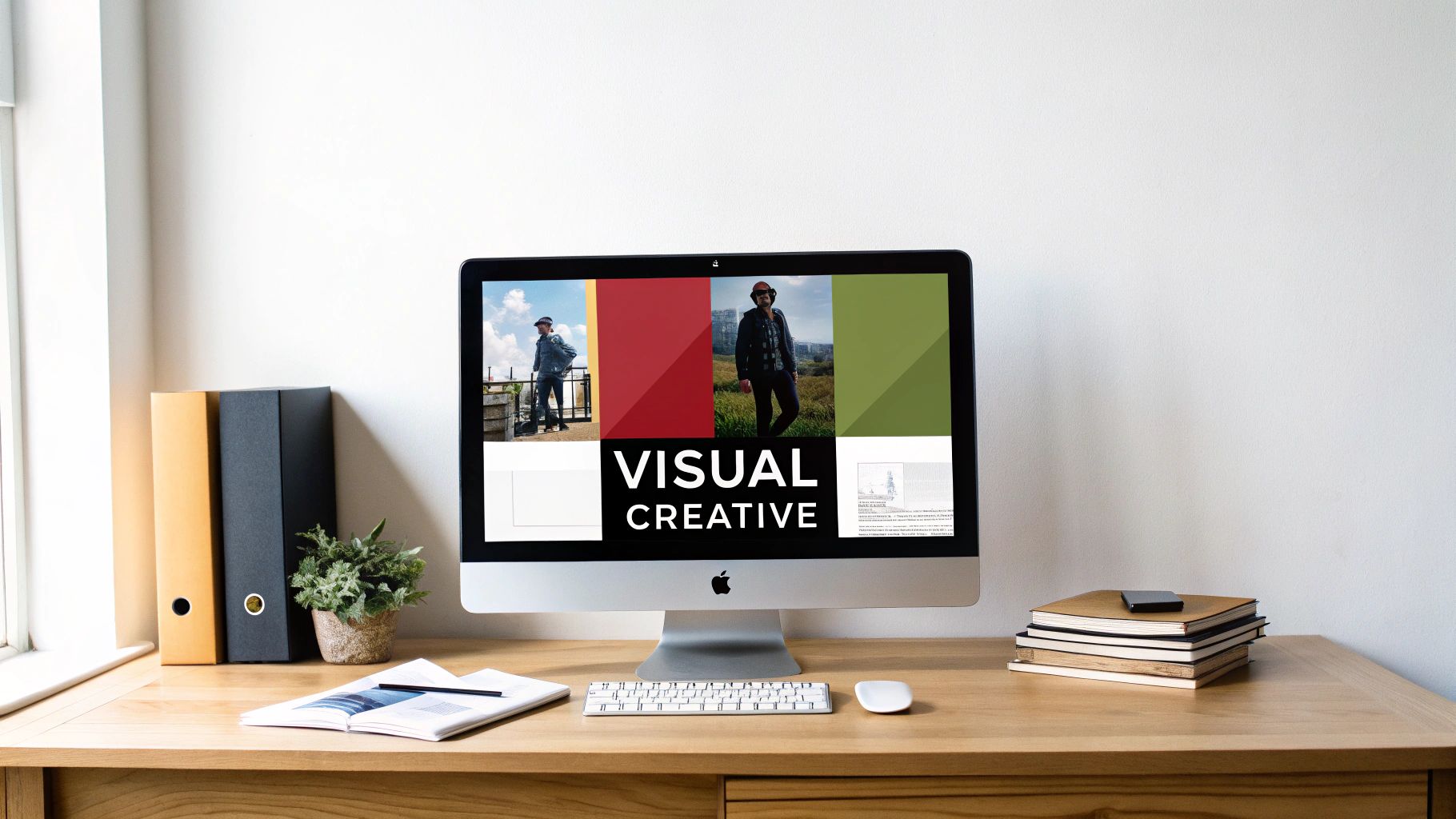
How to Implement Compelling Visuals
Developing standout creative involves a strategic blend of art and data. It starts with understanding your audience's aesthetic preferences and platform-specific formats.
- Videos: Use short, dynamic videos (under 15 seconds) with captions, as most users watch with the sound off. Brands like Tasty excel with quick, vibrant recipe videos that are instantly recognizable and shareable.
- High-Quality Images: Invest in professional photography or use high-resolution stock images that align with your brand. Glossier's minimalist product photography is a prime example of creating a strong, clean aesthetic.
- Carousels and Collections: Use these formats to showcase multiple products, features, or tell a sequential story. This interactive format encourages engagement and allows for more detailed product exploration.
- Graphics: Create bold graphics using tools like Canva. Incorporate your brand's colors and fonts for consistency. Humorous and on-brand video ads from companies like Dollar Shave Club built their entire identity on memorable creative.
Key Insight: The "80/20 visual rule" is a great guideline. Your ad creative should be approximately 80% visual and 20% text overlay to comply with Facebook's guidelines and maximize impact without overwhelming the user.
Actionable Tips for Success
Creating compelling visuals is an ongoing process of testing and learning. What works for one audience may not work for another, so continuous optimization is crucial.
- A/B Test Creative Elements: Test different visuals against each other. Pit a static image against a video, or test a lifestyle photo against a product-focused shot to see what drives better results.
- Use Bright, Contrasting Colors: Employ colors that pop against Facebook's blue and white interface to grab attention quickly.
- Ensure Mobile-First Design: Over 98% of users access Facebook on mobile. Design your visuals in a vertical (9:16) aspect ratio to fill the entire screen and create an immersive experience.
- Maintain Relevancy: Your visuals must be directly relevant to your offer and your target audience. A disconnect between the image and the message will lead to confusion and low conversion rates.
3. Clear and Compelling Call-to-Action (CTA)
A crucial element of effective Facebook ad best practices is crafting a clear and compelling call-to-action (CTA). Your ad creative and copy can be perfect, but without a powerful CTA, users won't know what to do next. An effective CTA uses specific, action-oriented language to guide the user toward your desired outcome, bridging the gap between interest and conversion. It creates clarity, communicates value, and removes friction from the user journey.
This is not just about choosing a button from Meta's list; it's about aligning that button with your ad's message to create an irresistible next step. A strong CTA can dramatically increase click-through rates and drive meaningful actions, whether you want sign-ups, sales, or downloads.

How to Implement a Powerful CTA
Choosing the right CTA happens at the ad level in Ads Manager. While you are limited to Meta's predefined CTA buttons, you can reinforce the action with compelling copy in your ad's headline and primary text.
- For Lead Generation: Use CTAs like "Sign Up," "Subscribe," or "Get Quote." HubSpot reinforces this by pairing "Start free trial" with copy that highlights the immediate, no-cost benefit.
- For E-commerce Sales: Buttons such as "Shop Now," "Get Offer," or "See Menu" are ideal. Amazon frequently uses "Shop the sale" during promotional events to create urgency and drive immediate purchases.
- For App Installs: The "Download" or "Install Now" CTAs are direct and leave no room for confusion.
Key Insight: The most effective CTAs promise a specific, tangible outcome. For example, Spotify's "Get 3 months free" is far more compelling than a generic "Sign Up" because it clearly communicates the immediate value the user will receive.
Actionable Tips for Success
Your CTA is a critical variable to test and optimize. A small change in wording can lead to significant improvements in performance.
- Match CTA to Objective: Ensure your CTA button aligns with your campaign objective. An awareness campaign might use "Learn More," while a conversion campaign needs a more direct CTA like "Shop Now."
- A/B Test Variations: Test different CTA buttons against each other. Does "Learn More" or "Get Offer" perform better for your audience? Use Facebook's A/B testing feature to get definitive data.
- Use Numbers and Specifics: Whenever possible, incorporate specific numbers or value propositions in the ad copy supporting your CTA. "Get 50% Off Today" is stronger than "Shop Our Sale."
- Ensure Landing Page Alignment: Your CTA must be consistent with the landing page it leads to. If your ad says "Get Your Free Ebook," the landing page should prominently feature the ebook download, not a generic homepage.
4. A/B Testing Everything
One of the most powerful Facebook ad best practices is to abandon guesswork and adopt a data-driven approach through systematic A/B testing. Instead of assuming what will work, A/B testing (or split testing) allows you to run controlled experiments with different ad elements to discover precisely what resonates with your audience. This process involves creating multiple versions of an ad, changing just one variable at a time, and letting performance data reveal the winner.
This methodical testing is the key to continuous improvement. By isolating variables like images, headlines, or audiences, you can make informed, incremental changes that compound over time, leading to significantly higher engagement, better conversion rates, and a more efficient use of your ad budget.
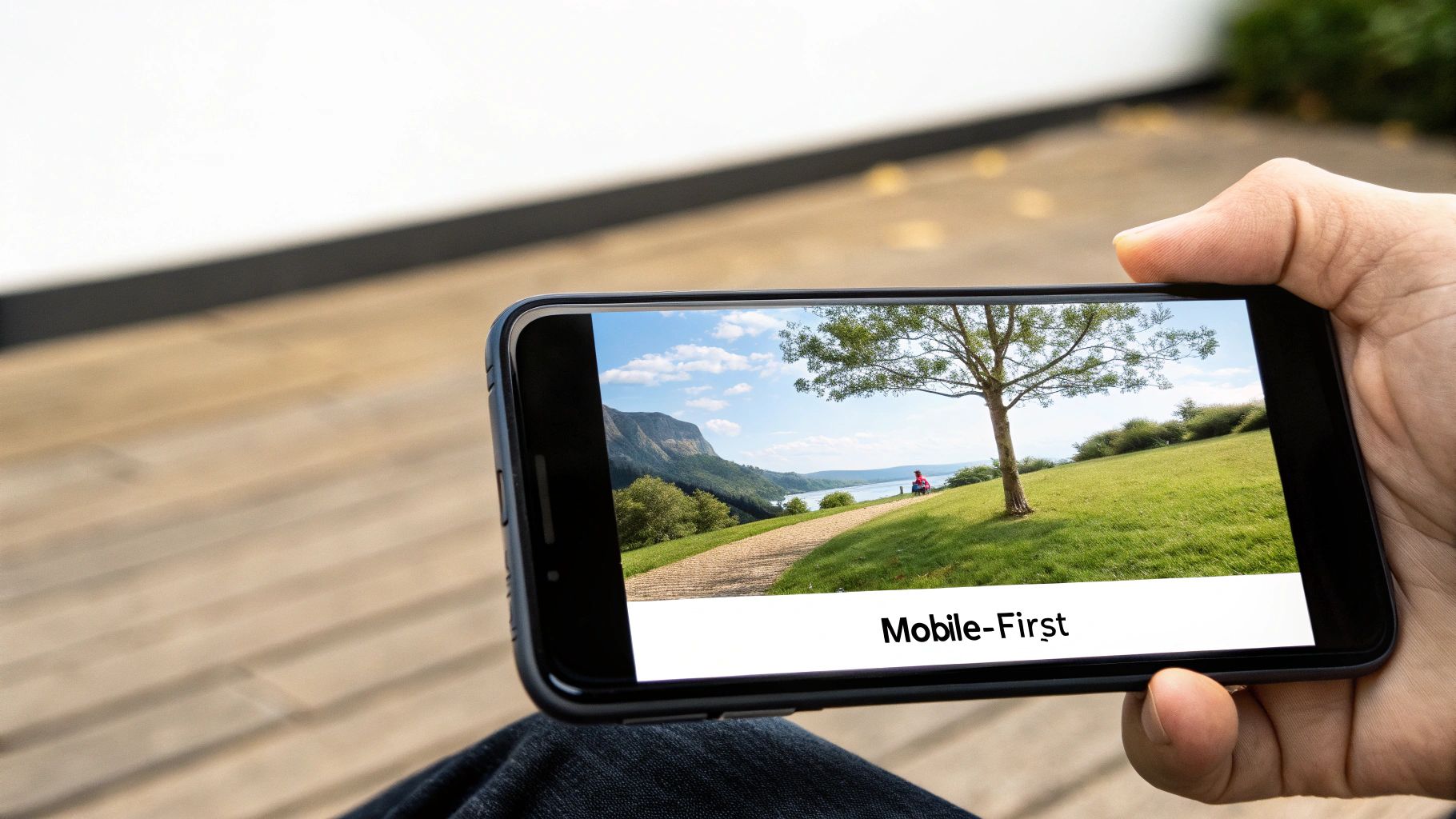
How to Implement A/B Testing
Facebook's Ads Manager has a built-in A/B testing tool that makes it easy to set up controlled experiments. When creating a campaign, you can select the "A/B Test" option to duplicate your ad set or ad and change a single variable.
- Creative: Test different images, videos, ad copy, headlines, or calls-to-action (CTAs). For example, Warby Parker might test a video showcasing their try-on feature against a static image of their best-selling frames.
- Audience: Test distinct audience segments against each other. Mailchimp could test an audience of small business owners against an audience interested in digital marketing platforms to see which yields a lower cost per lead.
- Placement: Compare the performance of ads on different placements, such as Facebook Feed versus Instagram Stories, to determine where your budget is best spent.
Key Insight: The golden rule of A/B testing is to test only one variable at a time. If you change both the image and the headline simultaneously, you won't know which element was responsible for the change in performance, making the results inconclusive.
Actionable Tips for Success
Effective A/B testing is a disciplined process that builds a library of knowledge about what works for your specific business and audience.
- Formulate a Hypothesis: Start with a clear question, like "Will a video ad generate more clicks than an image ad for this product?"
- Run Tests Long Enough: Allow your tests to run for at least 3 to 7 days to gather enough data for statistical significance. Ending a test too early can lead to false conclusions.
- Document Everything: Keep a detailed log of your tests, hypotheses, and results. This creates an invaluable internal knowledge base for future campaigns.
- Automate Where Possible: Use tools to streamline the testing process and scale your efforts. To explore how this works, see this guide on Facebook advertising automation.
5. Mobile-First Ad Design
An absolutely essential Facebook ad best practice is adopting a mobile-first design philosophy. With the vast majority of users accessing Meta's platforms via a mobile device, creating ads optimized for this experience isn't just an option; it's a requirement for success. Mobile-first design means building your creative assets specifically for smaller, vertical screens, prioritizing fast load times and designing for touch-based interactions.
This approach acknowledges that mobile users have different consumption habits. They scroll quickly and expect content to be instantly engaging and easy to digest. An ad that looks great on a desktop monitor can appear cluttered, cropped, or slow to load on a phone, causing users to scroll past without a second thought.
How to Implement Mobile-First Design
When creating your ad visuals in your preferred design tool or within Ads Manager, always prioritize the mobile layout. This ensures your message is clear and your visuals are impactful on the primary viewing device.
- Vertical Aspect Ratios: For placements like Stories and Reels, use a 9:16 vertical aspect ratio. For the main feed, a 4:5 ratio is optimal as it takes up more screen real estate than a traditional 1:1 square.
- Minimal Text on Images: Keep text overlays concise and bold. Facebook’s platform can penalize ads with excessive text on the image, and small fonts become unreadable on mobile screens.
- Fast-Paced Video: Create dynamic, short-form video content that captures attention immediately. Think quick cuts, vibrant motion graphics, and prominent branding. A mobile-optimized video ad for a new app might use quick, Snapchat-style cuts to showcase its main features in under 15 seconds.
Key Insight: The first three seconds of your ad are the most critical on mobile. Use this brief window to present your brand, core message, and main visual hook before the user has a chance to scroll away.
Actionable Tips for Success
Continuously test and refine your mobile creative to see what resonates with your audience. What works for one placement might not work for another.
- Test on Real Devices: Before launching a campaign, use the ad preview tool in Ads Manager to see how your ad looks on different mobile placements and devices. Better yet, send a preview to your own phone for a true user experience.
- Optimize File Sizes: Ensure your image and video files are compressed for the web without sacrificing too much quality. Aim for video file sizes under 4GB to ensure they load quickly on mobile networks.
- Add Captions to Videos: A significant portion of users watch videos with the sound off. Adding burned-in captions ensures your message is delivered even in silent-play environments.
- Design for Thumb-Stopping: Use bright colors, high-contrast visuals, and compelling human faces to make your ad stand out in a fast-moving feed. Your goal is to interrupt the user's scrolling pattern.
6. Retargeting and Custom Audiences
One of the most powerful Facebook ad best practices is leveraging retargeting with Custom Audiences. Instead of only pursuing cold leads, this strategy focuses on re-engaging users who have already shown interest in your brand. By using the Meta Pixel on your website or tracking app activity, you can serve highly relevant ads to people who have visited specific pages, added items to their cart, or engaged with your content. This "warm" audience is significantly more likely to convert because they are already familiar with your business.
Retargeting is the digital equivalent of a helpful store clerk asking a customer if they need help with an item they were just looking at. It keeps your brand top-of-mind and provides a gentle nudge to complete a desired action, dramatically improving your conversion rates and overall ad spend efficiency.
How to Implement Retargeting
To launch a retargeting campaign, you must first create a Custom Audience in your Ads Manager. This audience is built from data sources you control, such as your website traffic or customer list.
- Website Visitors: Create audiences based on user behavior, like those who visited your pricing page but didn't sign up, or users who spent a certain amount of time on your blog.
- App Activity: Target users who have taken specific actions within your mobile app, such as completing a tutorial or reaching a certain level in a game.
- Customer List: Upload a list of customer emails or phone numbers to match them with their Facebook profiles and deliver targeted ads for upselling or re-engagement. An e-commerce brand can use this to target users who abandoned their cart with an ad featuring the exact products they left behind.
Key Insight: The true power of retargeting is in its segmentation. You can create different Custom Audiences for various stages of the customer journey and tailor your ad messaging to each one, such as offering a discount to cart abandoners versus sharing new product features with recent visitors.
Actionable Tips for Success
Effective retargeting requires thoughtful execution to avoid ad fatigue and maximize impact. A well-structured approach will yield the best results.
- Segment Your Audiences: Don't just retarget all website visitors. Create separate campaigns for homepage visitors, product page viewers, and cart abandoners, each with a unique message.
- Use Frequency Caps: Set a limit on how often a single user sees your ad within a given period. This prevents your brand from appearing intrusive or annoying.
- Exclude Recent Converters: Be sure to exclude users who have already completed the desired action (e.g., made a purchase) from your retargeting campaigns to avoid wasting ad spend and showing irrelevant ads.
- Combine with Lookalike Audiences: Once you have a high-performing Custom Audience, use it as a source to create a Lookalike Audience. This allows Meta to find new users who share similar characteristics, effectively scaling your successful campaigns to a new, cold audience.
7. Video Content Optimization
Video has become the dominant content format on social media, and incorporating Facebook ad best practices for video is no longer optional, it’s essential for success. Video content optimization involves creating and formatting videos specifically for how users consume content on Meta's platforms. This means designing for short attention spans, sound-off viewing, and mobile-first experiences to capture and hold user interest effectively.
By tailoring your videos to the platform's algorithm and user preferences, you significantly increase your chances of stopping the scroll. A well-optimized video ad can communicate a message more dynamically and emotionally than a static image, leading to higher engagement, better brand recall, and increased conversions. Think of media companies like BuzzFeed, whose popular Tasty videos use quick cuts and text overlays to deliver value instantly.
How to Implement Video Optimization
Optimizing video content starts before you even hit record. Plan your ad with mobile viewing and short attention spans in mind. The goal is to deliver your core message within the first few seconds.
- Format: Design your video in a vertical (9:16) or square (1:1) aspect ratio. These formats take up more screen real estate on mobile devices, grabbing more attention than a traditional horizontal video.
- Captions: Assume your audience will watch with the sound off. Use clear, easy-to-read captions or text overlays to convey your message. Facebook's own data shows that 85% of videos are watched without sound.
- Thumbnail: Create a custom thumbnail that is bright, compelling, and clearly communicates what the video is about. A strong thumbnail can dramatically increase your video's play rate.
Key Insight: The first three seconds of your video are the most critical. You must hook the viewer immediately with a compelling visual, a surprising moment, or a direct question. Don't save your best content for the end; lead with it.
Actionable Tips for Success
Creating high-performing video ads is a process of strategic creation and iterative testing. Use these tips to improve your video engagement metrics.
- Front-Load the Action: Start with your most compelling shot or message. A sporting goods brand could open with an athlete mid-action rather than a slow introductory shot.
- Keep It Short: While Facebook supports longer videos, aim to keep your ads under 15 seconds. This length is optimized for in-stream and stories placements and has a much higher completion rate.
- Use Bright, High-Contrast Visuals: Make your video pop on a crowded feed. Use vibrant colors and clear visuals that stand out, even on small mobile screens.
- A/B Test Video Elements: Test different video intros, lengths, calls to action, and captions to see what resonates most with your audience. Small changes can lead to significant performance improvements.
8. Landing Page Alignment
A common mistake that undermines even the most brilliant ad creative is a disconnected landing page experience. One of the most crucial Facebook ad best practices is ensuring your landing page is a seamless continuation of your ad. Landing page alignment means the messaging, offer, and visual identity from your ad are mirrored on the page the user lands on after clicking. This consistency is vital for building trust and reducing friction.
When a user clicks an ad, they have a clear expectation based on what they just saw. If the landing page looks different, uses different language, or presents a conflicting offer, it creates confusion and causes them to bounce. A perfectly aligned experience confirms the user is in the right place, making them far more likely to complete the desired action, whether it's making a purchase or signing up for a trial.
How to Implement Landing Page Alignment
Achieving this seamless transition requires careful coordination between your ad creative and your web page design. The goal is to make the journey from ad to conversion feel like a single, cohesive step.
- Message Matching: The headline on your landing page should match or closely echo the headline in your Facebook ad. The same applies to the core value proposition and call to action.
- Visual Consistency: Use the same color scheme, fonts, imagery, and overall brand style on both your ad and landing page. If your ad features a specific product photo, that exact photo should be prominent on the landing page.
- Offer Congruence: Ensure the offer presented in the ad (e.g., "50% Off," "Free Trial") is immediately visible and clear on the landing page, without requiring the user to search for it. For example, SaaS companies like HubSpot ensure their ads for free tools lead directly to a simple signup page for that specific tool, not their general homepage.
Key Insight: Treat your ad and landing page as two halves of the same whole. A strong ad earns the click, but a well-aligned landing page secures the conversion. The transition should be so smooth the user barely notices it.
Actionable Tips for Success
Continuously optimize your landing pages to ensure they are primed for conversions coming from your Facebook campaigns.
- Create Campaign-Specific Pages: Instead of sending all traffic to your homepage, build dedicated landing pages for each major ad campaign or offer.
- Match the CTA Button: The call-to-action button text on your ad (e.g., "Shop Now") should lead to a page where shopping is the immediate, obvious next step.
- Remove Distractions: On conversion-focused landing pages, consider removing the main site navigation and other unnecessary links that could draw the user away from the primary goal.
- Test Load Speed: A slow-loading page is a major cause of user drop-off. Regularly test your landing page speed and optimize images and scripts to ensure it loads in under three seconds.
9. Budget Management and Bid Strategy
One of the most essential Facebook ad best practices is mastering how you allocate your ad spend and choose your bidding strategy. Instead of letting your budget run without direction, strategic management ensures you get the most value from every dollar. This involves understanding Facebook's ad auction, setting appropriate daily or lifetime budgets, and selecting a bid strategy that aligns directly with your campaign objectives, ultimately maximizing your return on investment (ROI).
By taking control of your budget and bids, you can influence how competitively your ads participate in the auction and optimize for specific outcomes like conversions or leads. This is the difference between simply spending money and investing it intelligently to drive business growth.
How to Implement Smart Budgeting and Bidding
You can set your budget and bid strategy at the campaign or ad set level within Ads Manager. The right choice depends on your campaign goals and how much control you want over delivery.
- Campaign Budget Optimization (CBO): This option, now called Advantage Campaign Budget, allows Facebook's algorithm to automatically distribute your total campaign budget across the best-performing ad sets in real time. It's ideal for campaigns with multiple ad sets, as it efficiently allocates funds toward the highest-potential audiences.
- Ad Set Budgets: Setting budgets at the ad set level gives you more manual control, allowing you to dedicate specific amounts to different audiences regardless of their initial performance.
- Bid Strategy Selection: Choose a strategy based on your primary goal. For instance, an e-commerce brand might use "Cost per Result Goal" (previously Target Cost) to maintain a specific cost per acquisition (CPA), while an app company would optimize for cost per install.
Key Insight: Your bid strategy tells Facebook what to prioritize. Choosing "Highest Volume" lets the algorithm spend your budget to get the most results possible, while setting a "Cost per Result Goal" or "Bid Cap" provides more control over costs, even if it means sacrificing some volume.
Actionable Tips for Success
Effective budget management is an ongoing process of monitoring and adjusting based on performance data. Use these tips to refine your approach.
- Start with Automatic Bidding: If you're unsure where to begin, use the "Highest Volume" bid strategy (automatic bidding) to let Facebook establish a baseline cost per result.
- Set Realistic Bid Caps: When using manual bidding, set your bid cap about 20-30% higher than your target CPA to give your ad enough competitiveness in the auction.
- Monitor Ad Frequency: Keep a close eye on the "Frequency" metric. If it gets too high (typically above 3-4 for a cold audience), it may be a sign of ad fatigue, indicating you should either expand your audience or lower the budget for that ad set.
- Test CBO vs. Ad Set Budgets: Run A/B tests to see which budgeting method delivers better results for your specific campaigns and audiences.
10. Performance Monitoring and Analytics
Launching a campaign is only the beginning; one of the most crucial Facebook ad best practices is the continuous monitoring and analysis of its performance. Instead of a "set it and forget it" mentality, you should treat your campaigns as living entities that require ongoing optimization. This involves systematically tracking key metrics to understand what’s working, what isn’t, and where to allocate your budget for the best results. Effective analytics turns raw data into actionable intelligence, allowing you to make informed decisions that directly boost your return on investment (ROI).
By regularly diving into your performance data, you can identify trends, diagnose problems early, and capitalize on opportunities. This proactive approach ensures your ad spend is always working as hard as possible to achieve your specific business goals.
How to Implement Performance Monitoring
The primary tool for this is Facebook Ads Manager, which provides a comprehensive dashboard of metrics. The key is to focus on the data points that align directly with your campaign objectives.
- E-commerce: Track the entire funnel, from ad click and Add to Cart to Initiate Checkout and Purchase. Monitor metrics like Cost Per Purchase and Return on Ad Spend (ROAS).
- SaaS Companies: Focus on lead generation metrics like Cost Per Lead (CPL) and track the conversion rate from a free trial sign-up to a paid subscription.
- Local Businesses: For brick-and-mortar stores, monitor metrics like Store Visits (if available) or track offline conversions like phone calls and direction requests generated from ads.
Key Insight: Don't get lost in vanity metrics like Likes or Reach. The most important data points are those tied to tangible business outcomes, such as conversions, leads, and sales. Your goal is to understand the cost and value of each desired customer action.
Actionable Tips for Success
A disciplined analytics process is what separates high-performing campaigns from mediocre ones. Build a routine around checking and interpreting your data.
- Focus on Business Objectives: Align your primary metrics with your overall business goals. If your objective is sales, ROAS is more important than Click-Through Rate (CTR).
- Use UTM Parameters: Add UTM codes to your ad URLs to get more granular tracking in tools like Google Analytics. This helps you see how Facebook traffic behaves on your website post-click.
- Automate Reporting: Set up automated reports in Ads Manager to be emailed to you or key stakeholders weekly. This keeps everyone informed and maintains accountability.
- Compare Time Periods: Analyze performance by comparing different date ranges (e.g., this week vs. last week, this month vs. last month) to spot trends or performance degradation. For a deeper understanding of this process, you can explore this guide on how to measure marketing effectiveness.
Facebook Ad Best Practices Comparison Table
| Strategy | Implementation Complexity 🔄 | Resource Requirements ⚡ | Expected Outcomes 📊 | Ideal Use Cases 💡 | Key Advantages ⭐ |
|---|---|---|---|---|---|
| Precise Audience Targeting | Medium – requires customer data and setup | Moderate – audience research and tools | Higher conversion rates, better ROAS, lower CPA | Targeting specific demographics or behaviors | Increased relevance, reduced ad fatigue |
| Compelling Visual Creative | High – needs design skills or budget | High – professional visuals creation | Higher CTR, improved engagement and brand recognition | Brands needing standout, engaging visuals | Better engagement, higher ad relevance |
| Clear and Compelling CTA | Low – simple copywriting | Low – messaging and button design | Increased conversions, clearer user actions | All campaigns requiring direct response | Clear guidance, improved conversion rates |
| A/B Testing Everything | High – systematic setup and analysis | High – budget and time investment | Continuous optimization, data-driven improvements | Optimization-focused campaigns | Reduced guesswork, better audience insights |
| Mobile-First Ad Design | Medium – specialized creative development | Moderate – creative adaptation | Higher mobile engagement, better ad delivery | Campaigns targeting mobile-heavy audiences | Enhanced UX, future-proofing ads |
| Retargeting and Custom Audiences | Medium – technical setup needed | Moderate – pixel implementation and data | Higher conversion rates, cost-effective advertising | Re-engaging warm audiences | Efficient funnel nurturing, better recall |
| Video Content Optimization | High – production and editing skills needed | High – video creation resources | Increased organic reach, storytelling, engagement | Brands leveraging video storytelling | Algorithm preference, strong engagement |
| Landing Page Alignment | Medium – coordination between teams | Moderate – landing page design and dev | Higher conversions, lower bounce rates | Campaigns focusing on direct conversions | Seamless user experience, trust enhancement |
| Budget Management and Bid Strategy | Medium – ongoing monitoring and adjustments | Moderate – budget allocation | Optimized spend, better ROI, scalable campaigns | Campaigns needing financial control and scaling | Cost control, ROI maximization |
| Performance Monitoring and Analytics | High – requires analytic skills and tools | Moderate – software and reporting tools | Data-driven optimization, clear ROI measurement | All campaigns needing performance tracking | Early issue detection, KPI-focused scaling |
Putting It All Together: From Strategy to Automation
Navigating the landscape of Facebook advertising can feel complex, but mastering it is far from impossible. The ten pillars we've explored, from laser-focused audience targeting to meticulous performance analytics, form a comprehensive blueprint for success. These aren't just isolated tips; they are interconnected components of a holistic strategy. Think of them as gears in a machine: when each one is calibrated and working in concert, the entire system runs with powerful efficiency.
Adopting these Facebook ad best practices means moving beyond simply "boosting" posts and embracing a methodical, data-driven approach. It’s about understanding that compelling creative is only as good as the audience it reaches, and a perfect audience is useless without a clear call-to-action and a seamless landing page experience. Each element builds upon the last, creating a chain of user interactions that guides a prospect from initial interest to final conversion.
From Good to Great: Key Takeaways
The difference between a campaign that breaks even and one that delivers exceptional ROI often lies in the details. Here are the most critical takeaways to internalize as you refine your approach:
- Audience is Everything: Your journey begins and ends with your audience. Invest the time to build detailed Lookalike Audiences and leverage Custom Audiences for retargeting. This single practice prevents wasted ad spend more than any other.
- Test Relentlessly: Never assume you know what will work best. A/B testing isn't a one-time task; it's an ongoing process. Test your ad copy, your visuals, your headlines, and your CTAs to continuously uncover higher-performing variations.
- Mobile-First is Non-Negotiable: With the vast majority of users accessing Facebook on mobile devices, designing for the small screen is essential. Prioritize vertical video, concise text, and fast-loading landing pages to capture and convert on-the-go audiences.
- Data Drives Decisions: Your Ads Manager dashboard is your source of truth. Regularly monitor key metrics like CTR, CPC, and CPA, but also connect them to your ultimate business goals. A low-cost click that never converts is not a victory.
The Critical Next Step: Bridging the Gap with Automation
Implementing these best practices will undoubtedly elevate your campaign performance and generate a steady stream of interest. However, for lead generation campaigns, a crucial challenge remains: the post-click bottleneck. Manually downloading leads from Facebook's native tools introduces a significant delay between a lead expressing interest and your sales team making contact. This gap is where conversions are lost.
This is precisely where automation becomes a game-changer. By integrating a tool that instantly syncs your new Facebook leads with your core business systems, you eliminate manual data entry and, more importantly, you eliminate the delay. Imagine your sales team receiving lead details in their CRM or a shared Google Sheet the very second a user hits "submit." This enables immediate follow-up when the lead's interest is at its peak, dramatically increasing the likelihood of a successful conversation and conversion. As you integrate these practices, a broader strategic perspective is key to skapa vinnande annonser i sociala medier that consistently deliver results.
By combining the strategic Facebook ad best practices discussed throughout this guide with smart, tactical automation, you create a powerful, end-to-end system. You’re not just running ads; you’re building a predictable, scalable, and highly efficient engine for business growth.
Ready to eliminate manual lead entry and ensure instant follow-up with every prospect? LeadSavvy Pro automatically syncs your Facebook Lead Ads directly to your Google Sheet or CRM in real-time. Stop letting hot leads go cold and start converting more effectively today with LeadSavvy Pro.


